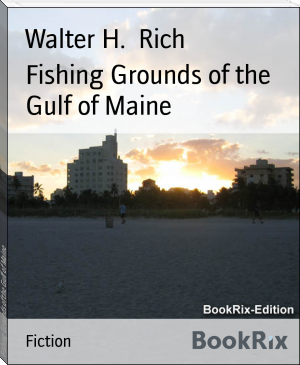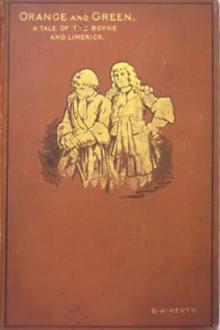Fishing Grounds of the Gulf of Maine, Walter H. Rich [readnow txt] 📗

- Author: Walter H. Rich
Book online «Fishing Grounds of the Gulf of Maine, Walter H. Rich [readnow txt] 📗». Author Walter H. Rich
Tides run NE. in flood and SW. on the ebb and are quite strong, the flood being the heaviest. Because of these powerful currents, fishing is somewhat difficult, it being necessary to make sets at the slack of the tides, getting the gear over and traveling with the finish of the current, to take it up and come back with the tide's return.
Clarks Ground. This lies SSE. from White head 4½ miles (just inside the Bulkhead) and has depths from 6 to 14 fathoms over a rocky bottom. Here are very heavy rips on the ebb tide. This is a good summer ground for pollock, cod, and halibut, and it is a good herring-netting ground in the season.
Southern Head Reef. The chain of reefs extending S from White Head Island is all good ground in summer for cod and for pollock, also, when the herring schools are on this ground. Currents are very heavy here. The ledges that make up this reef are more or less connected. Among these are Brazil Shoal, Tinker, Inner Diamond, Outer Diamond, Crawleys, Rans, Proprietor (Foul Ground), and the Old Proprietor. While virtually all this reef is pollock ground, Crawleys and Rans perhaps furnish the best fishing.
Gravelly. Lying about 5 or 6 miles SE. by S. from White Head, this piece of bottom has about 25-fathom depths over a rocky bottom. This is a cod and pollock ground in their season. While an occasional halibut is taken here in summer. Heavy tide rips occur here also.
The Soundings. Mentioned elsewhere as a herring ground, these lie outside the Bulkhead Rips 8 or 9 miles SE. from White Head. There are 30 or 40 fathoms of water here over a rock bottom, where pollock and cod are found in good number in July, August, and September, and a certain amount of halibut in summer.
Bulkhead Rips, also called The Ripplings. This is a long rocky barrier rising sharply from the deep water about it to depths of from 12 to 20 fathoms. Here are found cod, haddock, hake, and pollock in abundance from June 1 to October 31. Apparently all are feeding on the small herring, so numerous in this vicinity at this season. Virtually no haddock are found on the grounds in the near neighborhood of Grand Manan in winter. The Ripplings were formerly one of the principal fishing grounds of the herring netters but of late years have been less productive.
Cards Reef. The depths here are from 28 to 30 fathoms, over rocks, and the ground lies 3 miles S. by E. from the Old Proprietor and 9 miles from White Head. This is a cod and haddock ground from June to November.
Gannet Rock. This lies east of the Murre Ledges. All about it is good ground in from 40 to 70 fathoms over a hard bottom. Cod are found here in good number from March to May, and halibut are taken here from March to May, inclusive.
Southeast Ground and Gravel Bottom. These lie S. of Seal Island, forming an extensive piece of fairly level ground extensive piece of fairly level ground. The western part bears a little E. of S. and the eastern part about ESE. from the island. It is about 5 or 10 miles in diameter. While this is really but one piece of ground, the eastern part is called the Southeast Ground and the western part, from the nature of its bottom, the Gravel Bottom. The eastern portion is muddy and has 40 to 60 fathoms. The western has 35 to 40 fathoms. It is a good cod ground in winter and spring. Haddock are present from November to March, inclusive; hake in summer. Fishing is done mainly by trawling by sloops and vessels.
Machias Seal Island. Nineteen miles E. by S. from Moosabec Light. This furnishes good ground in the water all about it, where depths are from 15 to 54 fathoms over a generally rocky and uneven bottom. In summer cod, haddock, and pollock are abundant here, the cod and haddock remaining all winter. The fishery is carried on mostly by the smaller vessels from Maine ports, principally those from Cutler, with an occasional visit by larger craft, usually from the Portland fleet. This ground is not much visited in winter. Fishing is done by trawling and hand-lining.
Gannet Rock. This lies east of the Murre Ledges. All about it is good ground in from 40 to 70 fathoms over a hard bottom. Cod are found here in good number from March to May, and halibut are taken here from March to May, inclusive.
[Table I--Fishing Grounds of the Bay of Fundy Area of the Gulf of Maine, showing the principal species taken upon them.]
[Footnote 9: It (Fundy) was not clearly indicated by Verrazano (1524) nor in the report of Gomez (1525), who probably saw something of its entrance but fog or other unfavorable circumstances may have prevented him from observing it more accurately, but we find in the first old Spanish maps, in the latitude where it ought to be, names like these:
Rio hondo or 'fondo' (a deep river) or Bahia Hondo (a deep bay), or Golfo (a gulf) once, also 'La Bahia de la ensenada', the bay of the deep inlet.
Doctor Kohl, here quoted further says "On the maps of the seventeenth and early part of the eighteenth century, especially, it is written Bay of Funda. I believe that this name grew out from and is a revival of, the old Spanish name 'Bahia fondo'".]
[Footnote 10: It is gratifying to announce that the winter of 1925-26 saw a large run of herring on this ground, where for a number of years past there has been virtually no fishing for this species.]
[Footnote 11: "According to Porter C. Bliss, a thorough student of the Indian dialects, Acadie is a pure Micmac word meaning place. In Nova Scotia and Maine it is used by the Indians in composition with other words, as in Pestum-Acadie; and in Etchemin, Pascatum-Acadie, now Passamaquoddy, meaning 'the place of the pollocks'" (Doctor Kohl, _Dis. of Maine_, p. 234)
"This derivation is doubtful. The Micmac word Quoddy, Kady, or Cadie means simply a place or region and is properly used in conjunction with some other noun; as, for example, Pestum-oquoddy (Passamaquoddy), the place of pollocks." (Dawson and Hand, in _Canadian Antiquarian and Numismatic Journal_)
"La Cadie, or Arcadie: The word is said to be derived from the Indian Aquoddiaukie, or Aquoddie, supposed to mean the fish called a pollock. The Bay of Passamaquoddy, 'great pollock water,' if we may accept the same authority, derives its name from the same origin." (Potter, in _Historical Magazine_, I, 84)]
INNER GROUNDS
Under this heading are listed those grounds of the innermost chain of shoals, ledges, and "fishing spots", patches of rocky and gravelly bottom, the deeper water between them being over the muddy ground, which line the coast of the Gulf of Maine, making of it an almost continuous piece of fishing ground. In the Reports of the United States Bureau of Fisheries, on which all the statistics of the catch and value of the various species quoted in this report are based, these figures are grouped under the heading "Shore".
The larger and more important of these grounds are outcroppings along the edge of the 50-fathom curve and lie at distances varying from 12 to 20 miles offshore; but there are many inside this line, and where the deep water of the Gulf of Maine extends so far inshore some are close in to the land. Thus, nearly all are within comparatively easy reach even for the smaller craft (where these all now have power) and so furnish productive fishing for a large fleet of gill netters and sloops (small craft of from 5 to 10 tons net) and to the myriad of "under-ton" boats (of less than 5 tons net), all these being enabled to run offshore, "make a set," and return the same day.
With the uncertainties of the weather and the hazards of the winter fishing, very often the large vessels also follow this practice on those not too frequent "fish days" (when conditions permit fishing "outside ") that intervene between the storms; and with the scarcity of fish in the markets usual to the season and the consequent better price for the catch, with ordinary fishing luck they are well paid for doing so.
The fish of these shore grounds, due perhaps to the greater abundance of food here, are thought to be distinctly superior in quality to those of the same species taken on the offshore banks. The cod and the haddock, especially, of the Gulf of Maine are particularly well conditioned fish and are noted for their excellence.
The figures presented in Table 2 show only a fraction of the catch from the Inner Grounds, since they deal entirely with the fares of fishing vessels of 5 net tons and over. There are literally thousands of the so-called "licensed" or "under-tonned" boats, mainly gill-netters, that take millions of pounds from these waters annually, principally cod and haddock.
On the Maine coast and across the line in New Brunswick there are more than 300 weirs which furnished to American smokers and canners during the year 1923 (whose figures have been chosen as representing an average season) 77,000,000 pounds of herring. On the coast of Massachusetts there are 50 or more weirs and fish traps, and from the Isle of Shoals to Pemaquid Point in Maine there are more than 50 floating traps in the various bays, on the points of offshore islands, or even in the open sea, and all these take a rich harvest from these waters. Then, too, there is the lobster fishery, more important in the Gulf of Maine than anywhere else in the United States.
Of these various branches of the fisheries industries few statistics are available, yet we may say that the figures of the 1919 census showed that the "under-ton" boats mentioned landed 5,324,426 pounds of fish at the port of Boston, mostly of cod and haddock, and that the same type of craft in 1923 landed at Portland, Me., more than 3,000,000 pounds, principally of ground fish. We also know that every island, hamlet, village, town, and city along this nearly 4,000 'miles of coast line takes its toll from the sea.
Lukes Rock. This rock lies S. by E. 3 miles from Moosabec Light, circular in shape, and about 1 mile in diameter. Depths are from 25 to 35 fathoms; the bottom is rocks, gravel, and mud. This is mainly a small-boat fishing ground, but there is some vessel fishing. Hake are taken here from June to September, inclusive; cod are present about the rocks the year around. Pollock are here in spring and fall, and haddock from December to February, inclusive. Fishing is by trawl and hand line.
Newfound Ground. A small rocky spot about 1/4 mile across with an automatic buoy in the center





Comments (0)